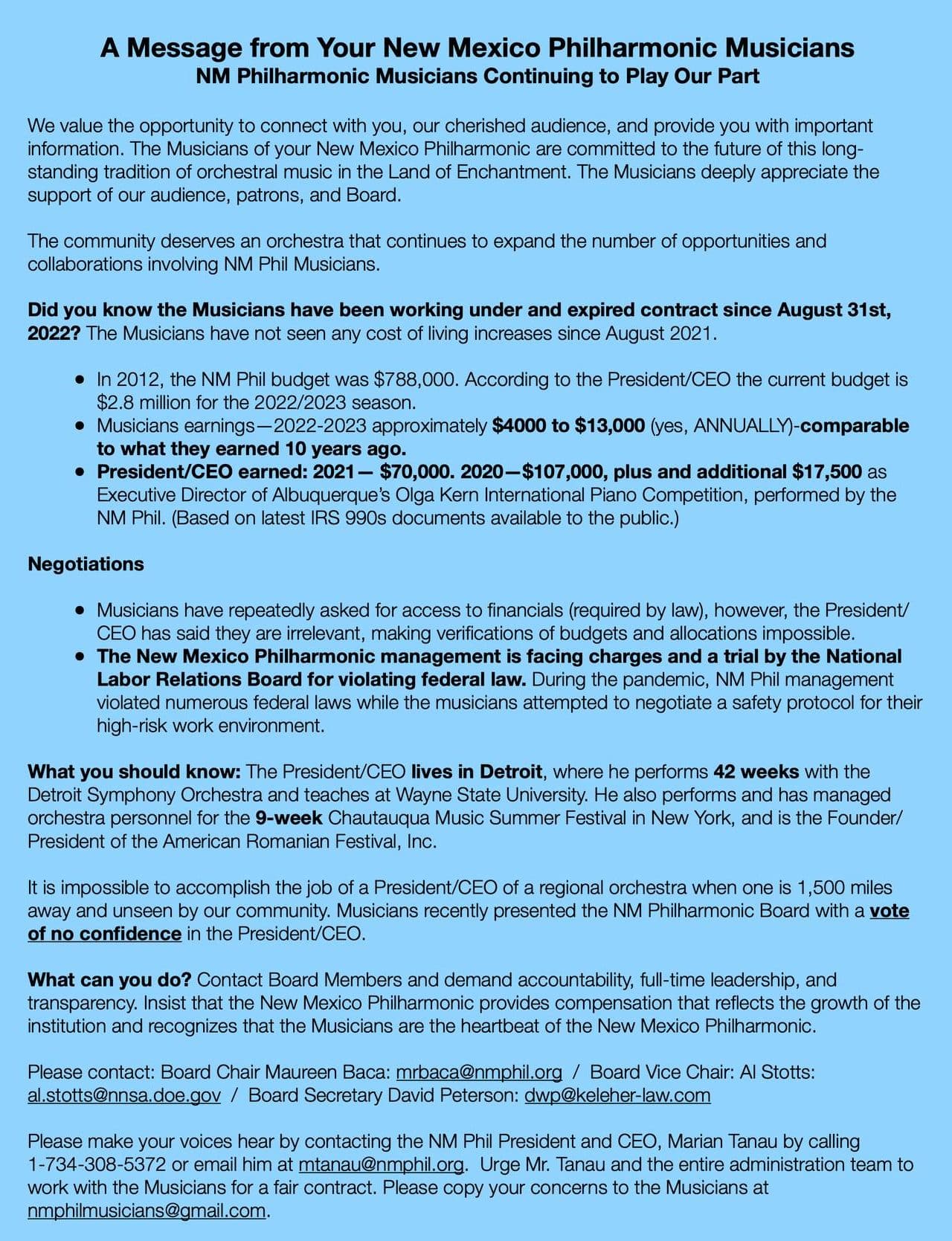Shocking wage gap in a US orchestra
OrchestrasPlayers in the New Mexico Philharmonic are paid just $4,000-13,000 a year.
Their part-time president and CEO, Marian Tanau, earns $107,000. Tanau lives in Ann Arbor, Michigan, and draws a second salary playing in the second violins of the Detroit Symphony Orchestra.
New Mexico’s music director is the Brazilian Roberto Minczuk.
The musicians have raised a vote of no confidence in Tanau and have published a manifesto (below, click on image to enlarge).
From the NMPhil website: The New Mexico Philharmonic (NMPhil) is the state’s largest professional classical symphony orchestra, and second only to the Santa Fe Opera, is the largest performing arts organization in New Mexico. It is the flagship classical music organization in New Mexico, performing for 40,000+ audience members and serving 20,000+ students each season and is a vital part of New Mexico’s cultural scene. It is also an important economic driver as a key cultural asset that helps to create the quality of life that attracts and keeps businesses and individuals in the community. NMPhil musicians are also employed by all professional music organizations in New Mexico that use classically trained professional musicians, further enhancing the quality of life in the state.







Our system of funding the arts by and for the wealthy, concentrates arts funding in the few financial centers where most of the wealthy live. Regional arts institutions thus face a great deal of neglect. Public arts funding in the social democracies of Europe allow for a much more democratic distribution of arts funding.
Public arts funding in Europe also took place among the most brutal dictatorships, absolutist monarchies, sanguinary revolutions and ethnic slaughters.
Well so did a lot of things, like eating, drinking, breathing…
Behind the charm of Santa Fe is a majority minority state, and one of the poorest in the nation. How many hours of work do the musicians do to earn their modest salaries? The musicians need to pressure the Board of Directors for the disparity in salary between them and their CEO, who, by the way, took a 30% pay cut in 2021, according to their manifesto, which is not easy to read in the form it is presented here. The pattern of paying salaries to administrators of non-profit organizations that look like corporate salaries is, unfortunately, pervasive throughout the United States – just look at the salaries of administrators of major hospitals, which can sometimes rise to the seven figures.
How can the manager not even live in New Mexico? That’s ridiculous – and so is the salary.
Maybe if they had a fulltime CEO in residence there year round things might be different. Who lets deals like this happen?
Who allows this to happen? Boards of Directors. And as has been stated several times on this site, Boards are usually made up of those who have zero idea of the arts organisations they are supposed to be leading. When a Board appoints a CEO who lives so far away, this proves once again how utterly incompetent these particular Board members are.
The part-time and non-resident status may be unusual, but this type of disparity in pay between a non-musician CEO and the performing musicians is quite common in the US.
Check the pay of the musicians vs that of the top administrators (not considering the Musical Director here) for most regional orchestras. You will find per service pay of as low as $75 – 80 for section players vs top admin salaries of over $100,000 easily. Even higher per service pay of $125 – 130 with 80 guaranteed services as found in some areas fails to translate to a “living wage” for the musicians.
This is spot on. I would say MOST regional orchestras in the US run this way. Music Director and ED makes six figures, while players are lucky if they make $15,000/year.
Maybe the bigger message here is that New Mexico doesn’t need a “philharmonic”. Have a hard time believing the sound is much good.
Perhaps the “bigger” message is that the New Mexico Philharmonic doesn’t need an absentee ceo that is effectively doing nothing but sending out a few emails while he plays in a full time orchestra 1500 miles away and runs two festivals that are even farther away, as well as a competition locally that benefits only himself and the namesake of said competition.
New Mexico doesn’t “need” a philharmonic any more than you need a mobile phone; the question is whether the philharmonic provides value to the community. You have a hard time believing that the sound is much good, yet you don’t have any concrete information about their level of playing to base your opinion on.
Well stated.
I’d suggest they proofread their manifesto before blasting it.
Their are a few errors. That said, do you have anything to say about the actual content of the manifesto?
20+ years professional player, 15+ years manager of orchestras this size.
1. Immediately fire both the music director and CEO.
3. Begin search for both under the stipulation that both are RESIDENT. Don’t worry, there are SO MANY fish in the orchestra sea.
If it’s true that the CEO is not in fact a resident of Albuquerque, that is nothing short of being absolutely CRIMINAL. What a bald faced grifter!
Remember, it’s the Board that does any firing and hiring. Boards relate to CEO types more than to freelance musicians. The Board owns the “New Mexico Philharmonic” name too and for legal purposes *is* the orchestra.
Albuquerque is a city of 560,000; big enough, one would think, for a busier orchestra.
How in the world can they have a President who is a full-time member of a major orchestra 1500 miles away? If they can exist with such a part-time management, the orchestra might as well self-govern.
But don’t begrudge the $107k salary in and of itself; whoever has the job has responsibility for an institution, not just to show up and play.
I find it quite interesting that over Tanau’s time there, the orchestra management has increased the budget by about 2 million dollars (in effect, about 400 percent what it was when he took over), while in effect not applying any of that to the salaries of the actual players, or the quality and quantity of their actual musical offerings. Where is that money going?
I doubt that the CEO isn’t their only problem. Look at the Music Director – it’s Roberto Minczuk of Brazil – who had a pretty frightening history with his musicians in his home country. Why is he even still working? What a creep.
Good stuff
A music director should: 1. live in the area and 2. be paid no more than the least-highest paid full-time musician. Shame on this person.
with that rule in place, only those who are seriously dedicated to conducting will take it on, rather than someone looking to make a quick buck
You’d think they might bother to learn the difference between “an” and “and”.
I played with the Stockton Symphony in California for 8 years. We faced the same problem all the time. Back in 2014 the wages for orchestra members (non-concertmaster) was about $87-$109 per service and there were 39 services for the entire season. You can do the math for how much we earned per year. Meanwhile, the executive director was making over $70,000 by sitting in her fancy office in a newly renovated corporate building, yelling at the musicians and refusing to be transparent about the association’s finance.